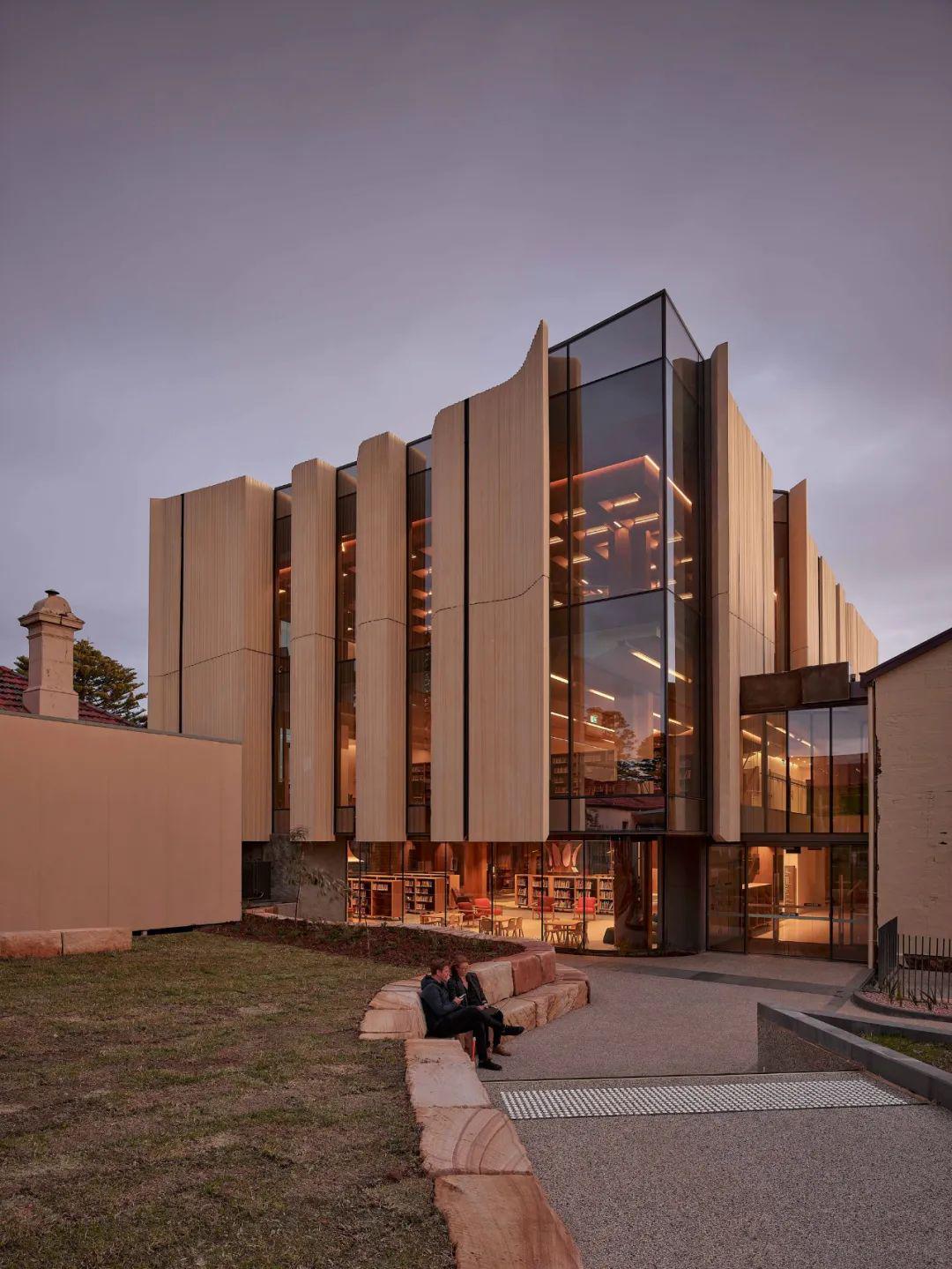Warrnambool图书馆和学习中心取代了现有的当地图书馆,在Warrnambool的CDB中心有一个更大、更明亮、更容易进入的空间。新空间位于西南TAFE校园,为当地社区和西南TAFE学生和工作人员提供设施。该空间包括一个现代化的室内外café、公共计算机、展览和展示区、学习和阅读的地方、会议室、专门的儿童区、游戏和数字媒体区。该项目是维多利亚州政府、西南TAFE和Warrnambool市议会合作的成果,实现了将教育、社区和艺术结合在一起的愿景。

Warrnambool图书馆和学习中心取代了现有的当地图书馆,在Warrnambool的CDB中心有一个更大、更明亮、更容易进入的空间。新空间位于西南TAFE校园,为当地社区和西南TAFE学生和工作人员提供设施。该空间包括一个现代化的室内外café、公共计算机、展览和展示区、学习和阅读的地方、会议室、专门的儿童区、游戏和数字媒体区。该项目是维多利亚州政府、西南TAFE和Warrnambool市议会合作的成果,实现了将教育、社区和艺术结合在一起的愿景。
Text description provided by the architects. The Warrnambool Library and Learning Centre replace the existing local library with a much larger, brighter, and more accessible space in the heart of Warrnambool’s CDB. The new space is located on the South West TAFE campus and provides facilities for both the local community and South West TAFE students and staff. The space includes a modern indoor-outdoor café, public computers, exhibition and display areas, places to study and read, meeting rooms, a dedicated children’s area, and games and digital media zone. The project is the outcome of a partnership between the Victorian Government, South West TAFE, and Warrnambool City Council and realizes a vision to bring together education, community, and the arts.

通过广泛的公众咨询,该项目的概念框架支柱是:
? 愉悦——自然光、与户外的联系、不同的光照水平、光作为衡量时间流逝的一种方式。
? 历史、遗产和叙事——确保设计反映当地历史、遗产,以支持创建引人注目的设计叙事。
? 第三空间——为思想交流、娱乐以及建立关系创造空间。
Drawing on extensive public consultation, the project’s conceptual framework pillars were:? Delight - Natural light, connection with the outdoors, different light levels, light as a way to measure the passing of time.? History, Heritage and Narrative - Ensuring the design reflects local history, heritage to support the creation of a compelling design narrative.? The Third Place - Creating space for the exchange of ideas, enjoyment, and to create and build relationships.


该项目包括一个新的3层现代建筑,通过玻璃连接通道与翻新的1868年的单层秩序室相连,这是工地上9个具有遗产意义的建筑之一。
The project included a new 3-storey contemporary building connected by a glazed linkway to the refurbished heritage-listed single-storey 1868 Orderly Room, one of nine buildings on site with heritage significance.


连接道作为一条巷道运行,支持穿过校园的行人连接,并清楚地将列入遗产名录的建筑与新结构区分开来。
The linkway operates as a laneway that supports pedestrian connection through the campus, and clearly delineates the heritage-listed building from the new structure.
剖面图
另一个符合新旧特征的关键设备是一座“桥”,它在一楼创建了一个额外的连接,那里是 Orderly Room 内的原始舞台所在的位置。以类似的表演方式运作,平台提供足够的空间供座位或表演,这座桥还提供了贯穿两座建筑的景观。
Another key device fitting the character of the old with the new is a “bridge” that creates an additional connection at the first-floor level where the original stage within the Orderly Room was located. Operating in a similarly performative manner, with landings offering space enough for seating or performances, the bridge also delivers views throughout both buildings.

现代建筑的弧形立面展示了Warrnambool和海洋的精选景观,悬垂的预制混凝土定义了当代上层的建筑语言,并为相邻的列入遗产名录的海关大楼提供了背景。这些动画形式允许立面从玻璃元素和策划视图中剥离,并在整个设计中调节日光和阴影。
The curved facade of the contemporary building reveals curated views over Warrnambool and the ocean, with draped precast concrete defining the architectural language of the contemporary upper levels, as well as providing a backdrop for the adjacent heritage-listed Customs House. These animated forms allow the facade to peel away from glazing elements and curate views, as well as regulate daylight and shading throughout the design.

室内设计参考了Robert Hoddle 建立的Warrnambool CBD 网格和 Orderly Room 内的网格格子天花板。这有意扩展了与城市和遗产建筑的现有建筑关系,并将当代建筑和遗产建筑结合在一起。网格和铰接式天花板体现在每个新楼层的设计中,不同的天花板布置作为对原始天花板的当代解构。
The interiors reference both the Warrnambool CBD grid, established by Robert Hoddle, and the gridded coffered ceiling within the Orderly Room. This intentionally extends an existing architectural relationship with the city and the heritage building and serves to bind the contemporary and heritage buildings together. The grid and articulated ceiling manifest in the design throughout each new level, with differing ceiling arrangements acting as a contemporary deconstruction of the original ceiling.
立面图

通过在可能的情况下适应性地再利用材料,并谨慎选择需要最少的长寿命建筑材料,已将环境影响降至最低。景观美化支持当地的多样性和林荫道的长期发展。还安装了雨水花园。
The environmental impact has been minimized via adaptive reuse of materials, wherever possible, and careful selection of long-life building materials requiring minimal. Landscaping supports local diversity and the long-term development of tree avenues. Rain gardens have also been installed.

项目信息


















